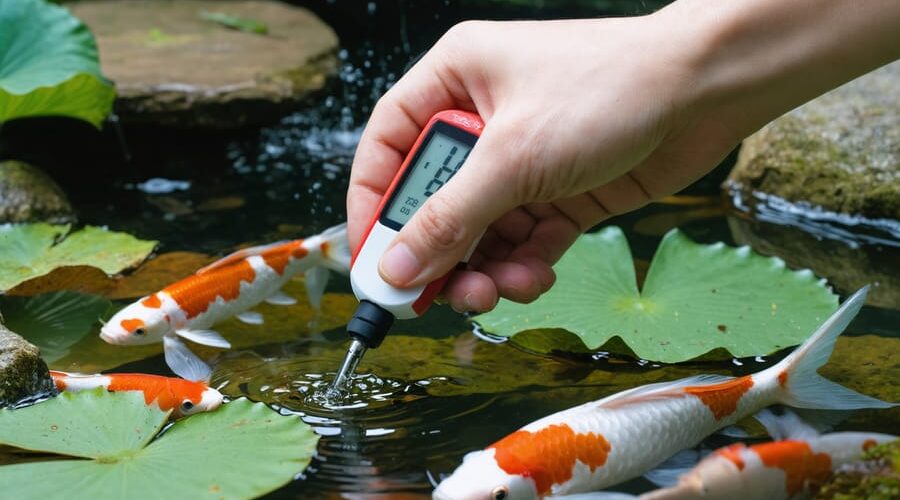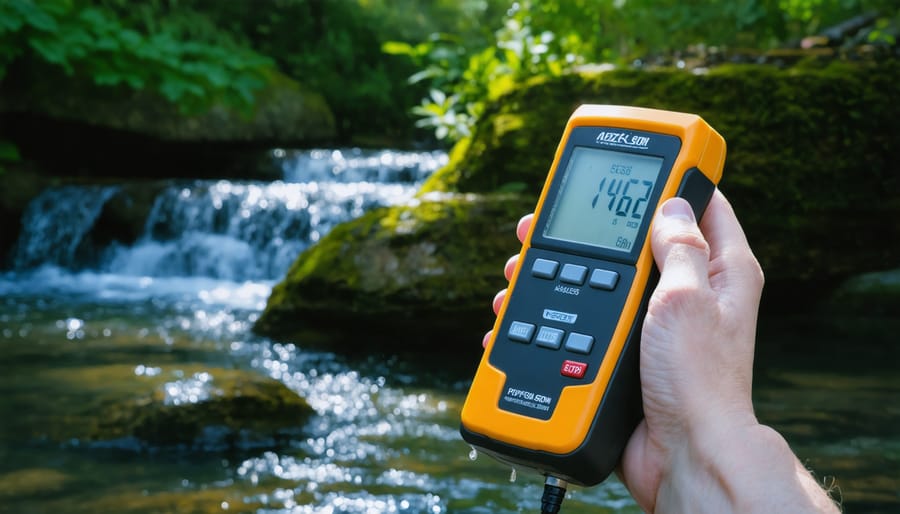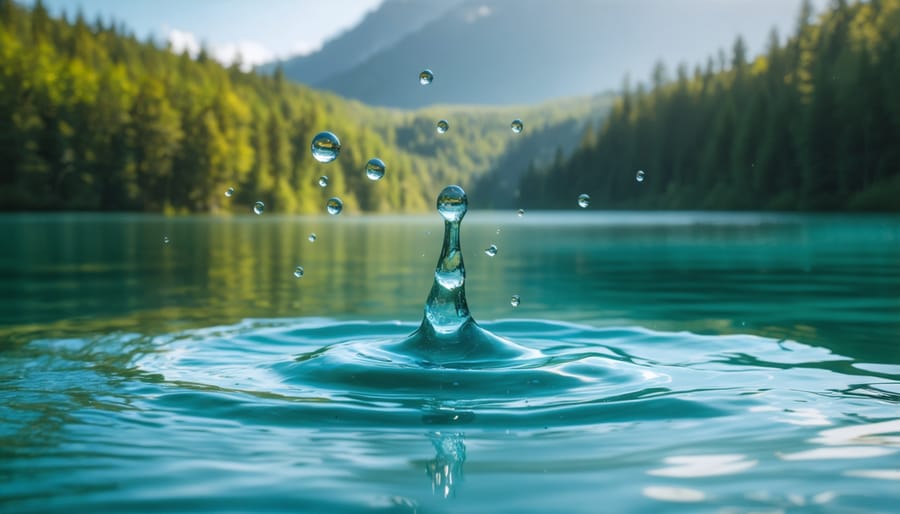
Your Pond is Lying to You About Its Water Quality
Your pond’s water looks crystal clear, but beneath that sparkling surface, invisible changes might be putting your fish at risk right now. I learned this the hard way three summers ago when I lost half my koi population overnight because I didn’t catch an ammonia spike in time. I was checking the water by eye, assuming everything looked fine, completely unaware that deadly chemical imbalances were building up.
Water quality monitors take the guesswork out of pond care by measuring the parameters you can’t see: pH levels, dissolved oxygen, temperature, and harmful compounds like ammonia and nitrites. Think of them as your pond’s early warning system, catching problems before they become disasters. Instead of waiting until your fish are gasping at the surface or your plants start dying, you’ll know exactly what’s happening in your water at any moment.
Whether you’re managing a small backyard pond or a larger water feature, understanding monitoring equipment doesn’t require a chemistry degree. Modern monitors range from simple handheld testers you dip into the water to sophisticated digital systems that send alerts to your phone. The key is matching the technology to your pond’s needs and your comfort level with equipment.
This guide breaks down everything you need to know about water quality monitors in plain language, helping you decide which type suits your situation, what parameters actually matter for your pond, and how to use monitoring data to keep your aquatic ecosystem thriving year-round.
What Water Quality Monitors Actually Do (And Why You Need One)
The Parameters That Matter Most
Let me explain the key water parameters you’ll want to monitor, without getting too caught up in the science-speak. Think of these as the vital signs of your pond’s health.
pH measures how acidic or alkaline your water is, on a scale from 0 to 14. Most pond fish thrive between 6.5 and 8.5, with 7 being neutral. When pH swings too high or low, fish become stressed, their immune systems weaken, and beneficial bacteria struggle to do their job. maintaining proper pH levels creates a stable environment where everything functions smoothly.
Dissolved oxygen is simply the amount of oxygen available in the water for fish and beneficial bacteria to breathe. Warm water holds less oxygen than cold water, which is why summer can be challenging. Low oxygen levels cause fish to gasp at the surface and can lead to dangerous ammonia buildup.
Temperature affects everything in your pond, from fish metabolism to bacterial activity. Monitoring temperature helps you anticipate when problems might arise and adjust feeding schedules accordingly.
Ammonia comes from fish waste and decaying organic matter. Even small amounts are toxic to fish, causing gill damage and stress. In a healthy pond, beneficial bacteria convert ammonia to nitrites, then to nitrates.
Nitrites are the middle step in this conversion process. Like ammonia, they’re harmful to fish, interfering with their ability to absorb oxygen. Brief spikes are normal in new ponds, but persistent levels indicate your biological filtration needs help.
Nitrates are the final, least toxic form in this nitrogen cycle. While safer than ammonia or nitrites, high levels encourage algae growth and can stress fish over time. Regular water changes keep nitrates manageable.
Spotting Problems Before They Become Disasters
I learned about the power of early detection the hard way. A few summers ago, I returned from a weekend trip to find my pond looking like pea soup. An algae bloom had exploded overnight during a heatwave, and by the time I noticed, my fish were gasping at the surface. I lost three beloved koi that weekend, all because I didn’t catch the oxygen drop in time.
That painful experience taught me what continuous monitoring could prevent. When oxygen levels start declining, you usually have hours, not days, to respond. A monitor would have alerted me before things went critical, giving me time to add aeration or perform a water change.
Fish kills are just one disaster that monitoring prevents. I’ve heard countless stories from fellow pond keepers who avoided catastrophes because their monitors caught problems early. One friend noticed her pH spiking after adding new rocks, potentially harmful to her healthy aquatic plants and fish. She removed them immediately, crisis averted.
Another common scenario happens during spring when beneficial bacteria populations haven’t fully recovered yet. Ammonia can spike dangerously as fish become more active and feeding increases. Without monitoring, this silent killer often goes unnoticed until fish show stress symptoms, sometimes too late for intervention.
The pattern is clear: problems rarely announce themselves dramatically. They creep up gradually, becoming emergencies only when left unchecked. Monitoring gives you that precious early warning system, transforming potential disasters into manageable adjustments.
Types of Water Quality Monitors for Every Budget
Test Strips and Liquid Test Kits: The Starting Point
When I first started maintaining my backyard pond, I thought testing water quality would be complicated and expensive. I was pleasantly surprised to discover that test strips and liquid test kits offer a simple, affordable way to get started.
Test strips are incredibly user-friendly. You simply dip the strip into your pond water, wait about 60 seconds, and match the colors to a chart on the bottle. They typically test for pH, ammonia, nitrites, and nitrates all at once. I keep a bottle in my garden shed and can check my water quality in less than two minutes. They’re perfect for quick routine checks and cost between $10 to $25 for a container that lasts several months.
Liquid test kits require a few more steps. You collect a water sample, add drops of reagent chemicals, and compare the resulting color to a reference card. While this takes five to ten minutes longer than strips, many pond keepers find them more accurate, especially for critical parameters like ammonia. Expect to spend $15 to $40 for a comprehensive liquid kit.
Here’s the honest truth about both methods: they work beautifully for regular monitoring and troubleshooting occasional issues. However, they only provide snapshots of your water quality at specific moments. If your pond experiences rapid changes, you might miss important fluctuations between tests.
For accurate readings, always test at the same time each day, rinse your hands before handling strips, and store test kits in cool, dry places away from sunlight. Check expiration dates too, as outdated kits produce unreliable results. These manual methods remain excellent starting points for anyone beginning their water quality monitoring journey.

Digital Handheld Meters: The Middle Ground
If you’re ready to step up from test strips but aren’t quite prepared for a full monitoring system, digital handheld meters offer the perfect middle ground. These compact devices deliver lab-quality results right at your pond’s edge, and I can’t tell you how much more confident I became about my pond once I started using one.
The most popular handheld meters measure pH, TDS (total dissolved solids), and dissolved oxygen. Unlike test strips that rely on color matching, these digital readers give you exact numbers within seconds. When my pH meter reads 7.2 instead of “somewhere between yellow and orange,” I know exactly what adjustments to make.
Accuracy is where these devices really shine. A quality pH meter can measure within 0.01 units, while TDS meters detect even subtle changes in water chemistry that strips would miss entirely. For dissolved oxygen testing, digital meters are game-changers since visual methods are notoriously unreliable.
Using them couldn’t be simpler. Just rinse the probe, dip it into your pond water, wait for the reading to stabilize, and you’re done. Most models even store previous readings so you can track changes over time.
The maintenance commitment is minimal but important. You’ll need to calibrate your meters monthly using calibration solutions (think of it as resetting your device’s accuracy), and pH probes require storage solution to keep them functioning properly. Budget about five minutes monthly for upkeep.
These meters particularly benefit pond owners with sensitive fish like koi or goldfish, anyone dealing with recurring algae problems, or water gardeners who’ve outgrown the guesswork of basic testing. They’re also perfect if you’re the type who loves understanding exactly what’s happening in your pond ecosystem.
Continuous Monitoring Systems: Set It and Forget It
If you’re managing a larger pond or water garden and find yourself constantly dipping test strips into the water, continuous monitoring systems might just become your new best friend. Think of these as the ultimate hands-off solution for staying on top of your water quality without the daily testing routine.
These multi-parameter systems work by keeping specialized probes submerged in your pond 24/7, constantly measuring important parameters like pH, temperature, dissolved oxygen, and sometimes even ammonia or salinity. The probes connect to a display unit or hub that collects and analyzes all this data in real-time. It’s like having a dedicated water quality assistant working around the clock.
The real magic happens with the smart features. Many modern smart monitoring systems send alerts straight to your smartphone when something goes wonky. Your pH drops unexpectedly at 2 AM? You’ll know about it immediately, not when you discover struggling fish the next morning. These systems also log historical data, so you can spot trends and patterns over weeks or months, helping you understand your pond’s unique rhythm through different seasons.
The investment typically ranges from a few hundred to several thousand dollars depending on the sophistication and number of parameters monitored. When does it make sense? If you’re managing a koi pond with valuable fish, running a commercial water feature, or simply want peace of mind without daily testing chores, continuous monitoring pays for itself in early problem detection and time saved. For smaller decorative ponds or water gardens where you enjoy the hands-on testing process, weekly manual checks work just fine and keep costs down.

Essential Sensors Every Pond Owner Should Know About
pH Sensors: Your Pond’s Report Card
Think of pH as your pond’s personality test. Just like people, ponds have their own chemistry, and pH tells you whether your water is acidic, neutral, or alkaline on a scale from 0 to 14. Most healthy ponds hang out between 6.5 and 8.5, but here’s where it gets interesting: fish prefer slightly different conditions than plants.
If you’re keeping koi or goldfish, aim for 7.0 to 8.0—they’re happiest in neutral to slightly alkaline water. Plant-focused ponds can tolerate a bit more acidity, thriving anywhere from 6.5 to 7.5. When pH swings too far in either direction, stress kicks in. Fish become vulnerable to disease, plants struggle to absorb nutrients, and beneficial bacteria slow down their cleaning duties.
So how do pH sensors work? Most digital probes use a glass electrode that measures electrical charges in the water. When you dip the probe in, it detects hydrogen ions and converts that reading into a pH number on your display. Simple, right?
Here’s my friendly warning: pH sensors need regular calibration to stay accurate. I learned this the hard way when my readings seemed perfect, but my fish were clearly unhappy. Turns out my sensor had drifted off course. Calibration involves testing the probe in solutions with known pH values—usually 7.0 and either 4.0 or 10.0. Most sensors come with calibration packets and instructions. Plan to calibrate monthly during active months, and you’ll have readings you can trust. Your pond will thank you with crystal-clear water and thriving inhabitants.
Dissolved Oxygen Sensors: The Breath of Life
Think of dissolved oxygen as the invisible ingredient your fish absolutely need to survive—it’s literally the breath of life in your pond. Just like we need air to breathe, fish depend on oxygen dissolved in the water, and when levels drop too low, they’re essentially suffocating.
Healthy oxygen levels typically range from 6-8 mg/L, but here’s where it gets tricky: these levels constantly change throughout the day and across seasons. During summer, warm water holds less oxygen naturally, and at night when plants stop producing oxygen through photosynthesis, levels can plummet dangerously. I’ve seen ponds that look perfect during sunny afternoons test critically low at dawn—scary stuff if you have valuable koi!
Watch for warning signs like fish gulping at the surface, especially early morning, or congregating near waterfalls and fountains where water splashes and picks up oxygen. Algae blooms also consume massive amounts of oxygen when they die off, creating sudden emergency conditions.
This is where dissolved oxygen sensors become genuine lifesavers. Modern monitors continuously track oxygen levels and can automatically trigger aerators or fountains when readings drop below your set threshold. Imagine sleeping soundly knowing your system will spring into action if oxygen dips overnight—no more anxious 5 AM checks on summer mornings! Some advanced systems even send smartphone alerts, giving you peace of mind whether you’re home or away. For anyone serious about fish health, oxygen monitoring isn’t just helpful—it’s essential insurance for your aquatic friends.

Temperature Sensors: More Than Just Numbers
Temperature might seem straightforward, but it’s actually the conductor of your pond’s ecosystem orchestra. When water temperature rises, oxygen levels drop—that’s just physics. Meanwhile, your fish are heating up too, literally speeding up their metabolism and needing more oxygen right when there’s less available. This is why summer can be tricky for pond keeping.
Here’s where monitoring really shines in practical ways. During warm months, I’ve learned to adjust feeding schedules based on temperature readings. Fish digest food faster in warmer water, so they can handle more frequent meals. But once temperatures drop below 50°F, their metabolism slows to a crawl, and overfeeding becomes a real problem.
Temperature tracking also takes the guesswork out of winterization. You’ll know exactly when to transition to cold-water food formulas and when to stop feeding altogether. In spring, monitoring helps you time that exciting restart when your pond comes back to life. Instead of relying on guesswork or calendar dates that vary by region, your temperature sensor gives you personalized data for your specific pond.
Setting Up Your Water Quality Monitoring System
Where to Place Sensors for Accurate Results
Getting sensor placement right makes all the difference between reliable readings and frustrating false alarms. Think of your sensor as a tiny scientist that needs to be positioned where it can gather the most accurate information about your pond’s conditions.
Start by placing your sensors at mid-depth in your pond, typically about halfway down. This sweet spot avoids the extreme temperature swings at the surface while staying clear of settled debris at the bottom. I learned this the hard way when my first sensor sat too shallow and gave me wildly different readings every time the sun came out!
Avoid dead zones like behind waterfalls, in corners with poor circulation, or tucked under overhanging plants. Your sensor needs to sample water that’s actively moving and representative of your whole pond. If you notice certain areas where leaves always seem to collect or water appears stagnant, keep your sensors far away from those spots.
Speaking of debris, protect your sensors by positioning them away from feeding areas and heavy plant growth. A simple sensor guard or mesh sleeve works wonders for keeping curious fish and floating leaves from interfering with your readings.
For larger ponds or those with distinct zones like shallow plant shelves and deep center areas, consider using multiple sensors. This gives you a complete picture of what’s happening throughout your water feature. Place one in your main pond area and another in any separate bog gardens or streams that feed into your system.
Creating Your Testing Schedule
Think of testing your pond water like checking your car’s oil – regular monitoring prevents problems, but certain situations call for extra attention. For established ponds, I recommend testing weekly during spring and summer when biological activity peaks and temperatures fluctuate. Your fish are more active, plants are growing rapidly, and evaporation changes water chemistry faster than you’d expect.
During fall and winter, you can usually scale back to bi-weekly or even monthly testing since everything slows down considerably. New ponds need more frequent attention – test every other day for the first month as beneficial bacteria colonies establish themselves. This cycling period is crucial, and monitoring helps you avoid the heartbreak of losing fish to ammonia spikes.
After major events, always grab your testing kit. Heavy rainstorms dilute your pond and wash in debris, potentially causing pH swings and introducing contaminants. Adding new fish means more bioload, so test daily for at least a week afterward. The same goes for medication treatments or major cleanings – these shake up your pond’s delicate balance. Keep a simple testing log; patterns emerge that help you anticipate issues before they become problems.

Reading and Understanding Your Results
When to Take Action (And When to Relax)
Understanding when your water quality readings require action versus simple observation is one of those skills you develop with experience, but let me fast-track that learning curve for you.
Think of your pond’s ideal parameters as a comfortable room temperature. pH should hover between 6.5 and 8.5, dissolved oxygen above 5 mg/L, and ammonia and nitrites at zero. These are your happy zones where fish thrive and plants flourish.
When your monitor shows dissolved oxygen dropping below 4 mg/L, that’s an immediate red flag. Turn on your aerator, add water movement, and investigate quickly. Similarly, any ammonia or nitrite reading above 0.5 ppm demands swift action because these compounds are toxic to fish. I learned this the hard way when I ignored a slight ammonia spike and lost three beautiful koi within 48 hours.
On the flip side, pH drifting slightly above or below your target range isn’t an emergency. You have days or even weeks to address it using natural water treatment methods rather than rushing to dump chemicals in. Temperature changes follow seasonal patterns and rarely need intervention unless you’re dealing with tropical fish.
Water hardness and conductivity are even more forgiving. These parameters change gradually and are typically addressed during routine maintenance rather than emergency responses. Document your readings, watch for trends, and adjust your maintenance schedule accordingly rather than panicking over every fluctuation.
Keeping Your Monitoring Equipment Happy
Just like your pond pump needs a bit of TLC, your monitoring equipment deserves some love too. The good news? Keeping these tools in top shape is easier than you might think, and a little care goes a long way toward accurate readings and years of reliable service.
Let’s start with the basics. After each use, rinse your probes and sensors with clean water—distilled is best, but tap water works in a pinch. Gently wipe away any algae or debris with a soft cloth. I learned this lesson the hard way when I left my pH probe sitting in pond muck for a week. The readings were all over the place until I gave it a proper cleaning!
Storage matters more than most people realize. Keep your equipment in a cool, dry place away from direct sunlight. For pH and ORP probes, there’s a special trick: store them in storage solution or pH 4 buffer solution, never in plain water. This keeps the sensor tip hydrated and ready for action. Digital meters usually come with protective caps—use them religiously.
Speaking of problems, here are quick fixes for common headaches. Erratic readings? Try recalibrating with fresh solution. Slow response times often mean the sensor needs cleaning or replacement. Most probes have a lifespan of 1-2 years with regular use, so consider this when budgeting.
Make monitoring part of your regular maintenance routine. Replace calibration solutions every few months, check battery levels before testing sessions, and keep spare batteries handy. Your future self will thank you when everything works perfectly during those critical water quality checks.
Here’s the truth: monitoring your pond’s water quality isn’t nearly as complicated as it might seem when you’re just starting out. Once you take that first reading and jot down a few numbers, it quickly becomes second nature. Think of it like checking your email or watering your plants—just another simple routine that keeps things running smoothly.
The real reward is the peace of mind you’ll gain. Instead of wondering why your fish seem sluggish or your water looks cloudy, you’ll actually know what’s happening beneath the surface. You’ll catch problems before they become disasters, and you’ll understand your pond in a way that transforms you from a worried observer into a confident caretaker.
Every pond tells a story through its water chemistry, and with a good monitor in hand, you’re simply learning to read that story. You’ll make better decisions, spend less time guessing, and enjoy a healthier, clearer pond that reflects your dedication.
So take that first step. Pick up a test kit or invest in a digital monitor, and start getting to know your water. You’ve got this, and your pond will thank you for it.
